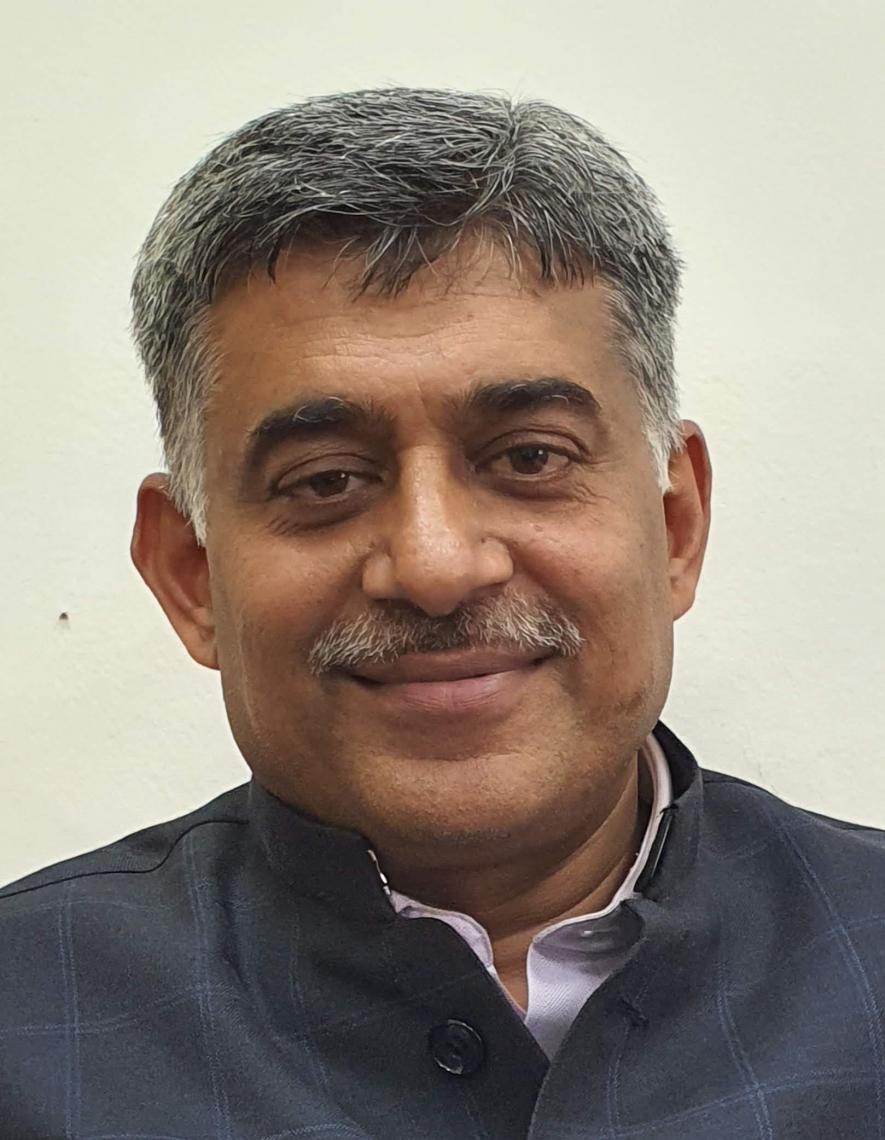‘Difficult to Predict how Many Waves of Covid-19 India will Have’—Vaccine Specialist Sanjay Rai
Representational use only. Image Courtesy: New Indian Express
Few had expected the second wave of the Coronavirus disease, or Covid-19, to sweep across India. As cities are placed under curfew and panic grips citizens, many are wondering: What explains the fresh outbreak of Covid-19? Is it because we had stopped taking precautions, such as wearing masks? Or it is that we cannot understand the sinister behaviour of Covid-19? Will vaccination protect us from getting infected? Are multiple brands of vaccines the panacea for our suffering?

To answer these questions, NewsClick turned to Dr. Sanjay K Rai, who is the Principal Investigator of Vaccine Safety and Efficacy Trial at the prestigious All-India Institute of Medical Sciences. In this capacity, he helped launch Covaxin, one of the two vaccines currently in use in India. Dr. Rai wears many hats—he is a professor at the Centre for Community Medicine of AIIMS, provides technical support to the National AIDS Control Organisation, and is currently involved in research on the human influenza disease burden in India. He has over 150 research papers. As President of the Indian Public Health Association, Dr. Rai has been studying the spread of SARS-CoV-2, the virus which causes Covid-19, and interpreting data to predict its behaviour in the months to come.
Was the second wave of Covid-19 expected?
Based on sero-surveillance reports, it can be said that a very big second wave was unexpected. At least 25% of Indian were said to have been exposed to SARS-CoV-2, the virus which causes Covid-19. In a few cities—for instance, Delhi, Mumbai, Pune, etc.—more than 50% of residents were reported to have been exposed to the virus. It was, therefore, never expected that the second wave would be bigger than the first one. The second wave has happened most likely because of a new variant [or mutant], which is highly infectious.
Is the new variant also more virulent than the original strain which caused Covid-19?
Until recently, the evidence we had was that the new variants were not as virulent as the first one. Or, to put it another way, the severity of the illness caused by the new variants would not be more than the original strain triggered. But we now have evidence, published in prestigious medical journals that are peer reviewed, that not only some of the new variants are more infectious but these also clock a higher mortality rate than the original strain of the virus did.
Most of the RNA [Ribonucleic Acid] viruses undergo mutations. Not all mutants or variants are of concern. Only some are. For instance, it is well established that the United Kingdom variant is highly contagious and, probably, more lethal as well. This UK variant has invaded many countries including India.
What about the South African variant?
There are three variants of concern, identified by their country of origin. These are the UK, South African, and Brazil variants. A fortnight ago, the genomic sequencing of around 10,000 samples in India showed that there were 771 samples with variants of concern. Of these, 95% were of the UK variant, 4% of the South African variant, and less than 1% of the Brazilian variant. The UK one is highly contagious and will likely spread across India.
You think the new variant or mutant is the primary reason behind the second wave—and not that people had stopped maintaining social distance and wearing masks?
Obviously the variant is the problem. It cannot be that people suddenly stopped adhering to Covid-appropriate behaviour and, therefore, Covid-19 cases started to soar. The rise in cases is happening not only in India but also in Pakistan and Bangladesh. It is not as if people of all three countries suddenly began to think that the pandemic is over and that they should stop wearing masks and maintaining social distance.
Not wearing masks is a contributory factor. The primary cause is the highly contagious new variant.
From this perspective, the Kumbh Mela and election rallies, where people are not seen wearing masks, can be suicidal, particularly if the UK variant is circulating among them.
This kind of virus spreads faster in crowded places, whether at the Kumbh Mela in Haridwar or election rallies. It will also spread faster in crowded restaurants and bars. The more people are squeezed into smaller places the more likely the virus will infect them.
Is it true that the young are getting more affected in the second wave than they were in the first one, as anecdotal accounts suggest?
I will again ask you to look at the evidence. There were three nationwide sero-surveys done by the Indian Council of Medical Research. Also, sero-surveys were done by the local authorities of Delhi, Mumbai, Pune, Chennai, etc. Look at any of these surveys and you will find that people of all age groups were exposed to the virus.
However, the symptoms were less in children (those below 18 years). That is why we did not expect them to be affected by the virus. For instance, Delhi’s sero-surveys showed that nearly 55% of its people had been exposed to the virus. By comparison, over 60% of children were exposed to the virus. Their exposure to the virus was higher in comparison to adults. But they neither showed symptoms nor reported clinical illness. As far as death among children went, it was almost negligible.
In our country, 2,200 children die of malnutrition every day. As per information available till now, Covid-19 does not make children severely ill. Even today, I do not think you will find so many children dying of Covid-19 in a month [as they do of malnutrition]. In a nutshell, I can say Covid-19 remains a very mild disease for children. This is true globally as well. In the UK, they did not close down schools, not even during the second wave, the peak of which was far higher than the first one. No doubt, Covid-19 is a very serious problem. But it is not the only problem we have. The pandemic management should be vetted against the benefit and harm of any suggested action and should not be at the cost of routine health services and livelihood.
The second wave has challenged the theory of herd immunity, hasn’t it?
There are multiple factors at play here. The theory of herd immunity holds true with the same type of virus. All that we can say is that the protection provided by herd immunity from the same type of virus is far better and more durable than provided by any vaccine. But the theory of herd immunity does not apply to new variants of the original strain. These new variants may bypass or cheat the immune system.
Antibodies produced by the human body to fight the virus…
The antibody is just an element of the complex mechanism of the human immune system. So, in other words, the new variants bypass or escape the immune system of the human, which cannot fight it. This often happens with the influenza virus, which mutates into new variants. It is for this reason new anti-influenza vaccines are given every year. As of now, we can say that the vaccines given in India protect people against the UK variant. But the South African variant seems to decrease the effectiveness of the vaccines.
It would seem India could have a third wave, fourth wave, even….
As per the scientific evidence available till now, it is difficult to predict how many waves of Covid-19 India will have. Mutation characteristics of the virus will decide the future waves of this pandemic. We certainly have to learn to live with this virus for a very long time.
There is much confusion about vaccines and infection. What does a vaccine do?
A vaccine reduces the risk for a person to get a disease, by priming up his or her natural immune system. So, when a person is vaccinated, the immune system produces antibodies to fight the disease and also remembers the disease. Thus, when a vaccinated person is exposed to the same germ in the future, his or her immune system quickly destroys the germ, in the present case SARS-CoV-2, to ensure he or she does not fall ill.
Some people developed symptoms or fell ill even after having been fully vaccinated.
There are several factors for this. First, no vaccine is 100% effective. The efficacy of any vaccine is against the occurrence of new cases of the disease. When we say Vaccine X has an efficacy of, say, 95, it means 95% reduction of new cases of a disease in the vaccinated group compared with the unvaccinated group. Efficacy does not mean a person will not be infected at all, ever. A person could be infected because the new virus mutant escapes the immune system, thus decreasing the efficacy of the vaccine.
For how long do antibodies generated by two shots of vaccines last in a person’s body?
Antibodies produced by natural infection to SARS-CoV-2 last for at least seven or eight months, as per evidence available. We do not have data beyond that duration. But that does not mean the antibodies in the human body will dip or suddenly disappear. For MERS-CoV [Middle East Respiratory Syndrome Coronavirus] and SARS-CoV [Severe Acute Respiratory Syndrome Coronavirus], the immunity lasted for two or three years. So, it is very likely that the immunity produced by exposure to SARS-CoV-2 could also last for two-three years.
What about vaccine-produced immunity?
We have data for seven to eight months. We believe the immunity should last for at least a year. Yet, at the same time, it needs to be stressed that vaccines do not necessarily protect against all new mutants of SARS-CoV-2.
A person infected with new variants could develop symptoms and fall ill, right?
Yes, nothing can be said about the efficacy of vaccines against some of the new mutants. This virus is just a year old and lots of data have been generated in this time. No new disease generated so much data in such a short period. The problem is that we are not using new evidence. We still engage in speculation. For instance, those who have been infected by the virus will have antibodies for at least six to eight months. Yet people get vaccinated, thinking it would boost their immunity. We do not have any scientific evidence that vaccines will boost immunity after natural infection. At the moment, vaccines are a precious commodity, which should not be wasted.
Do you think India faces the possibility of a vaccine shortage?
Reports are suggesting a mismatch between the demand and supply of vaccines. This is true of many developing countries. Around 14 crore people around the world have already been infected. They should not be part of the priority group for vaccination. What we are witnessing is a gross vaccine inequality between the developed and the developing world. India’s decision to export vaccines has contributed to bridging the mismatch. This should be appreciated.
Do you think the vaccination drive in India should have been accompanied by some curbs on our public life, as seems to have been done in the UK?
Covid-appropriate behaviour always plays an important role in any respiratory disease which spread from person to person. In India, the curve of Covid-19 cases grew steadily from March 2020 to peak at nearly a lakh of cases a day. The curve began to dip—and touched a low of less than 10,000 cases a day. As I said before, the sudden rise thereafter could not have happened only because people stopped wearing masks. The rise and fall in the Covid-19 graph are because of multiple factors. The new variants of the virus are contributing factors. Intensifying vaccination drive with some restraints in place is a smarter way of achieving community protection.
Give me an example.
There are multiple factors at play. Take a locality in Delhi, where, say, 70% of its residents have been exposed to Covid-19. You can say this locality has acquired herd immunity. But even in this locality, there would be still 30% of people not exposed to the virus. They are fine as long as they are confined to their locality. But once they go to a place that has not acquired herd immunity, then they are likely to get infected. It is safer for people to travel from an area that has not had high exposure to Covid-19 to one which has acquired herd immunity. The opposite is likely true for people travelling in the reverse direction. In fact, herd immunity applies when there is unity in the spread of the virus.
Unity here means the virus spreading equally across different economic groups?
Yes, we call it random distribution. Only when the said infection is randomly distributed, the population can be said to be safe. But all this holds true when the virus does not mutate. As long as we continue to get new mutants that bypass the human immune system, we will likely see as many spikes.
New brands of vaccines are coming into India. How does a consumer decide which to take?
Given the current situation, people will take what they will get. But yes, once the demand for vaccines comes down, it would become very confusing for consumers. The possibility of mix-up cannot be ruled out.
You mean a person who has taken a shot of Vaccine X and instead of taking the second shot of the same vaccine, he or she could possibly end up getting Vaccine Y.
Yes. We just don’t have any evidence of how safe and effective would a ‘cocktail’ of vaccines be. If all brands of vaccines are available at one place, it would be mighty confusing for both the giver and receiver of vaccines.
With different brands coming into the market, do you see intense, even destructive, competition taking place in the vaccine market?
It will certainly lead to the commercialisation of vaccines. More and more companies will enter into an agreement with vaccine developers to produce vaccines. After all, there is a lucrative market waiting for them.
What is its flip side?
Since the main objective of any business is to make profits, vaccines will stop being a matter of science. All attempts will be made to influence consumers, who will be exploited. This is not hard to visualise, is it? In fact, this is already happening. There is much talk about everyone getting vaccinated. Vaccines are important. But those who have already been exposed to Covid-19 need not take it, as I have already explained.
What about children?
It is all market strategy. Covid-19 is a mild disease in children. There is insufficient evidence that children exposed to the virus will develop severe illness. As of now, we have no vaccine which can be said to be safe and efficacious for children. Your readers might not know that children, until now, were not part of the Covid-19 vaccine trial. In the near future, though, they [pharmaceutical firms] will develop vaccines for children. Children are now already part of clinical trials. Vaccines for children are not being developed based on what science tells us. It is based on promoting commercial interests. Children constitute a very big market. In India, there are around 55 crore children. There are already a lot of discussions regarding vaccines for children. This may frighten parents, who, obviously, will do anything to protect their children.
You think children do not constitute a risk category?
It is a very mild disease for them. Yes, tomorrow a new mutant could come and it might affect the severity of the disease. But the vaccine developed for them now would anyway become useless for them against the new mutant. Why do we develop vaccines? We do it to reduce the mortality rate and suffering. If Covid-19 affects children mildly, you tell me, does it make sense to develop it for them, to vaccinate them?
Not unless we get a new variant and evidence shows children have become vulnerable to it.
You are right. But who can ever stop them from producing vaccines for children.
(Ajaz Ashraf is an independent journalist.)
Get the latest reports & analysis with people's perspective on Protests, movements & deep analytical videos, discussions of the current affairs in your Telegram app. Subscribe to NewsClick's Telegram channel & get Real-Time updates on stories, as they get published on our website.
























